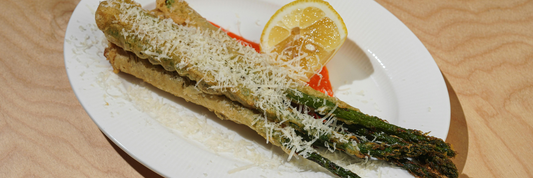Sushi, from a traditional Japanese dish to a global experience, is renowned for its variety of types and styles. So how can you maximize the variety on your sushi restaurant menu? Come discover the most popular sushi styles with us and find the way to optimize your sushi menu!
What Are Common Sushi Styles?
Sushi is getting increasingly diverse as the culinary world evolves, adapting to local tastes. Popular sushi styles nowadays might be categorized as traditional or Western-style. When comparing traditional and western-style sushi, the differences lie in several key aspects:
Ingredients:
- Traditional: Focuses on fresh, seasonal seafood like tuna, salmon, yellowtail, and eel. Uses simple ingredients like rice, fish, seaweed, and maybe some wasabi.
- Western: Often incorporates cooked or smoked ingredients like crab meat, salmon, and chicken. Embraces bolder flavors with additions like avocado, cream cheese, and spicy sauces.
Presentation:
- Traditional: Minimalist and elegant. Nigiri with just a single slice of fish, maki rolls tightly wrapped with nori on the outside. Focuses on showcasing the natural beauty of the ingredients.
- Western: More playful and creative. Uramaki rolls with rice on the outside and colorful fillings peeking through. Often uses decorative garnishes like tobiko (flying fish roe) and sauces.
Flavor profile:
- Traditional: Subtler and delicate, relying on the natural sweetness of the fish and the subtle tang of vinegar in the rice. Balanced and umami-rich.
- Western: More pronounced flavors with a wider range of sweet, savory, spicy, and creamy notes. Often uses bolder sauces and spices for a more exciting taste experience.
Preparation:
- Traditional: Requires meticulous skill and precision. Rice is cooked and seasoned with specific techniques. Each type of sushi has its own specific rolling and shaping method.
- Western: Sometimes uses simplified techniques or shortcuts. May use pre-cooked or flavored rice, and rolling methods may be less strict.
Overall, traditional sushi emphasizes simplicity, respect for the ingredients, and a focus on subtle flavors and textures. Western sushi, on the other hand, embraces innovation, bolder flavors, and playful presentation while still drawing inspiration from its Japanese roots.
Which style of sushi are your restaurant embracing? Is it traditional or Western in style? Have you ever considered how to optimize your sushi menu? Let's take a look first at the most common types of sushi and what makes each one unique, grouped by style. And then discover tips to optimize the sushi menu!

What Are the Most Popular Types of Traditional Sushi?
When it comes to traditional sushi, simplicity reigns supreme. The focus is on highlighting the quality and freshness of the ingredients, allowing their natural flavors to shine through.
Nigiri
- How it is made: Hand-pressed rice topped with a single slice of fresh fish or seafood. Each bite is a delicate balance between the sweetness of the vinegared rice and the subtle flavor of the fish.
- The ingredients: Tuna, salmon, and seabass are common choices, but adventurous diners can find options like mackerel, yellowtail, and even octopus.
- Why it's popular: Nigiri is considered the pinnacle of sushi artistry, showcasing the chef's skill in selecting and preparing the fish. It's a simple yet elegant dish that allows the natural flavors to shine.
Maki
- How it is made: Rolled sushi with seaweed (nori) and simple fillings like tuna, cucumber, or pickled vegetables. The rice tends to be less seasoned than in western-style maki, allowing the natural flavors to come through.
- The ingredients: Hosomaki (thin rolls) and futomaki (thick rolls) are common, with some variations featuring different seaweed shapes or additional fillings like egg or fish roe.
- Why it's popular: Traditional maki offers a more delicate and subtle flavor profile than western-style rolls. It's a great way to experience the classic combination of rice and seafood without overwhelming the palate.
Chirashizushi
- How it is made: Scattered sushi with seasoned rice topped with a variety of ingredients like fish, seafood, vegetables, and pickled ginger. It's a visually stunning dish that showcases the different textures and colors of the ingredients.
- The ingredients: There are many regional variations of chirashizushi, with some featuring specific ingredients or cooking methods.
- Why it's popular: Chirashizushi is a celebratory dish, often served on special occasions. It's a fun and interactive way to enjoy sushi, as diners can mix and match the different toppings to their liking.
Sashimi
- How it is made: Thinly sliced raw fish or seafood, served without rice or other accompaniments. The focus is entirely on the texture and taste of the fish, offering a pure and unadulterated experience.
- The ingredients: Similar to nigiri, a wide variety of fish and seafood can be used for sashimi, depending on the season and availability.
- Why it's popular: Sashimi is a true test of the quality of the fish. Only the freshest and most flavorful seafood can be served raw, making it a delicacy for discerning palates.
Oshizushi
- How it is made: Pressed sushi formed in a rectangular mold, often featuring layers of different ingredients like fish, vegetables, and egg. It has a smooth, even texture and a distinct flavor profile from other types of sushi.
- The ingredients: Oshizushi can be made with a variety of ingredients and toppings, depending on the chef's creativity.
- Why it's popular: Oshizushi is a beautiful and unique type of sushi that offers a different eating experience. It's also a good option for people who prefer their sushi to be cut into bite-sized pieces.

What Are the Most Popular Types of Western Style Sushi?
When it comes to Western-style sushi, the focus shifts towards bold flavors, creative combinations, and visually stunning presentations.
California Roll
- How it is made: Crab meat, cucumber, avocado, and often masago (capelin roe) wrapped in rice and nori. The familiar, mild flavors and creamy avocado make it a gateway sushi for many.
- The ingredients: Spicy California rolls add sriracha or chili paste, while veggie California rolls replace crab with tofu or other plant-based alternatives.
- Why it's popular: The California roll's mild flavor profile and accessible ingredients make it a safe bet for sushi newbies. Its adaptability also allows for customization and caters to dietary preferences.
Spicy Tuna Roll
- How it is made: Tuna salad mixed with sriracha or chili paste, often rolled with cucumber and avocado. The fiery kick and creamy textures offer a vibrant contrast.
- The ingredients: Tuna can be substituted with other spicy options like salmon or yellowtail. Some variations add mayo or masago for additional flavor and texture.
- Why it's popular: The spicy tuna roll satisfies adventurous palates who crave a bolder taste sensation. Its popularity reflects the Westernization of sushi with bolder, punchier flavors.
Rainbow Roll
- How it is made: A visually stunning roll with various colorful ingredients artfully arranged on the outside, like tuna, salmon, yellowtail, and avocado. It's a feast for the eyes and offers a diverse flavor experience.
- The ingredients: The specific ingredient combination can vary greatly, with some featuring rarer seafood or even vegetarian options.
- Why it's popular: The rainbow roll's visual appeal and diverse flavors make it a popular choice for sharing and special occasions. It's a testament to the creative freedom embraced in Western-style sushi.
Philadelphia Roll
- How it is made: Smoked salmon, cream cheese, and avocado rolled in rice and nori. The creamy richness and familiar flavors like smoked salmon make it a unique and popular choice.
- The ingredients: Some rolls might add cucumber or masago for extra texture, while others might substitute the salmon with other smoked fish options.
- Why it's popular: The Philadelphia roll's creamy texture and familiar flavors like smoked salmon bridge the gap between traditional sushi and Western palates. It's a gateway for those hesitant about raw fish.
Uramaki (Inside-Out Rolls)
- How it is made: Rice on the outside of the roll with nori and fillings on the inside. This provides a different visual and textural experience compared to traditional maki.
- The ingredients: Uramaki are incredibly versatile, encompassing countless ingredient combinations ranging from seafood and vegetables to tempura-fried options and vegetarian fillings.
- Why it's popular: Uramaki's visual appeal and endless possibilities for flavor combinations cater to diverse preferences. They offer a more playful and experimental approach to sushi compared to traditional styles.
Optimize Your Sushi Menu
Understanding the common styles of sushi, both traditional and Western, can be a powerful tool for optimizing your sushi menu. Here's how you can leverage this knowledge to attract customers and keep them coming back for more:
- Offer a mix of traditional and Western styles: Appeal to both purists who appreciate the delicate flavors of nigiri and sashimi and those who prefer the bolder, creative combinations of Western-style rolls.
- Balance familiar and adventurous options: Provide California rolls and spicy tuna rolls for those new to sushi, while also showcasing unique creations like rainbow rolls or vegetarian maki for more adventurous palates.
- Combo Magic: Create enticing combo deals that showcase different styles and offer a greater value than individual orders. This encourages sharing and exploration.
- Offer transparent labeling: Clearly identify the ingredients in your sushi, especially for those with allergies or dietary restrictions.
- Highlight signature dishes or unique creations that showcase your expertise and set you apart from the competition.
- Offer combination sets: Bundle popular dishes at a discounted price for a more satisfying experience.
- Run promotions and specials: Attract new customers and encourage repeat visits with limited-time offers.
- Consider catering: Expand your reach by offering sushi platters or bento boxes for events and gatherings
To put in brief, by understanding the different styles of sushi and catering to diverse preferences, you can create a menu that attracts a wider customer base and keeps your restaurant competitive in the market. Let’s review your menu now and take your restaurant to a new level.




